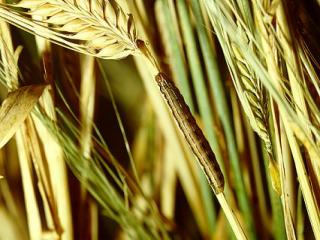Armyworm can be a threat to cereal crops
- Wubin
- Wittenoom Hills
Nick McKenna (Planfarm) reports finding low numbers (less than one per 10 sweeps) of armyworm caterpillars in an Impress CL Plus wheat crop near Wubin. The crop was at dough development.
Plant pathologist Andrea Hills (DPIRD) has found less than one armyworm per 10 sweeps in a Scepter wheat crop near Wittenoom Hills. The caterpillars could be seen feeding on the leaves.
It is that time of year again, when cereal crops are ripening and armyworm caterpillars may live up to their name, by damaging cereal crops in a wave like an army front. Growers are advised to check their cereal crops at this time as substantial areas of damaged crop are often not noticed until harvest time. This can be prevented by monitoring crops with a sweep net and visual inspection of caterpillars and plant damage.
Technical officer Amber Balfour-Cunningham (DPIRD) has found caterpillars up on barley heads in her barley trial site at Northam. Initially it was assumed these were armyworm but close inspection showed they were native budworm which must have come from nearby peas or weeds which had dried out. Unlike armyworm, native budworm are not known to feed on cereals unless forced onto them through the death of their preferred hosts such as canola and pulses. Another species however, called the lesser budworm, does feed on cereal plants and occasionally is detected and causes crop damage.
Managing armyworm in cereals
When there are sufficient numbers armyworm are known to cause the most economic damage to barley crops when the plants are starting to hay off and they chew or lop the heads off. Damage to wheat and oat crops occurs less frequently and is usually minor compared to damage in barley. Armyworms are seldom a serious problem in pastures.
Assessing the numbers of armyworm in a cereal crop can be difficult, as their movements will vary with weather conditions and feeding preference. Sometimes they are found sheltering on the ground and under leaf litter whilst on other days they will be high up on the plants or on the heads and easily picked up using sweep nets. This is important to note if sweep netting cereal crops. Larger caterpillars often prefer to hide during the day and feed at night.
The threshold for spraying armyworm in mature barley is about three large armyworm grubs per square metre of crop. The threshold for wheat or oats is much higher as only grains are consumed and heads are very rarely dropped. Spray thresholds in these crops are more like 10 grubs per square metre of crop.
A number of effective insecticides are registered for the control of armyworm if required (see the department’s Winter/Spring Insecticide Spray Chart 2018). Spraying late in the afternoon or evening is recommended as armyworms are predominately night feeders.
For more information refer to the department’s Diagnosing armyworm and Management of armyworm in cereal crops pages.
For more information contact Dustin Severtson, Development Officer, South Perth.

